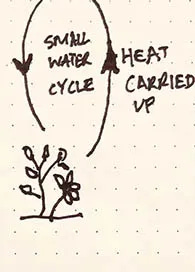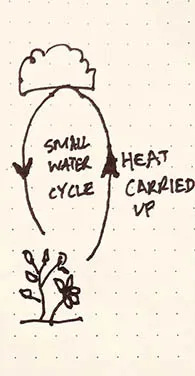Throughout this newsletter, I’ve been trying to bring attention to the biological dimension of climate, that part of the climate driven and orchestrated by living things and the processes between them. It’s a complicated story to tell, because the stance taken in defense of the living, or biological, view of climate can be misconstrued as being against the current, physical view of climate1, which isn’t the case. It’s why I like Millan Millan’s conception of a “two-legged” climate. The two legs, physical and biological, the greenhouse effect and the green-life effect, don’t stand in opposition to each other, but side by side, part of the same body, which is the Earth and it’s climate. In this way Millan’s image is not only clarifying, but unifying.
Another clarifying, and potentially unifying, image emerged recently during my readings and research, though in a very different way. The image is that of a blanket over a person sleeping, a common metaphor for describing the greenhouse effect, which I heard a physicist use while explaining global warming. In the past I haven’t given the image much thought, but when I heard it this time something clicked in my mind. “That it!” I thought. “That explains it.”
Explains what? To answer that we need to consider yet another image, a hand-drawn picture which I had come across earlier that day, and which had put the blanket-over-the-sleeping-person image in a whole new light.
This little drawing is by Alpha Lo, author of the Climate Water Project, provided as part of a three-piece series he’s written called Biodiversity Regulates Climate. Lo takes the reader on a mind-bending tour through the laws of thermodynamics and entropy to show how a biologically run climate makes perfect physical sense. Such laws can be difficult to grasp, but Lo brings them down to (and into) Earth, condensing the discussion into a single phrase which he repeats throughout like a mantra: energy flows, matter cycles.2
Let’s look at Lo’s drawing with this mantra in mind. Most of us already know that plants, through photosynthesis, transform sunlight into chemical energy which then flows into and powers the plant’s growth. If we drew a deer beside the plant and a cougar beside the deer, we’d see the energy flow laterally, into and through the living landscape, as matter cycles from plant to deer to cougar. But in Lo’s drawing energy doesn’t flow only into the system but also out, a significant amount sent on a U-turn straight back up to the sky.
And what is cycling? Water, in all its phases, up and down, liquid to vapor to ice to liquid again. The water cycles round and round and heat flows up: a plant-driven heat pump. Here’s how it works.
The cycle begins in the soil, which, if healthy and naturally vegetated, soaks up rainwater like a sponge while at the same time feeding aquifers. That’s good because the plant, grass or tree will need that water in the hot summer when the sun is strongest. And a lot of water is needed, over 100 gallons per day for a typical tree. About 90% of that water is brought to the undersides of its leaves, and exuded through pores in a process much like sweating called transpiration. Anyone who’s worn a sweat dampened t-shirt in the wind knows the cooling effect of evaporating water.
The process is cooling because the phase change from liquid to vapor requires heat. At the moment liquid water evaporates to vapor, heat flows into the vapor as kind of potential, called latent heat. The water vapor rises, eventually condensing to clouds and back to liquid again, as rain, at which point the heat is released, only higher in the atmosphere. As the small water cycle wheels around, it pulls heat from the lower atmosphere where CO2 is more concentrated, to the upper atmosphere where CO2 is slightly thinner, the air is colder and the heat is that much closer to space and final escape. It’s estimated a typical tree has the cooling power of two 5-star hotel refrigerators, but rather than sending the heat out the window into someone else’s air, it sends it up out of the living space.
It’s a living heat pump with a beautiful logic—the more water cycled the more heat removed. Add the fact that the more life growing in a landscape the more water it can cycle, and you arrive at simple formula: to cool the planet grow and protect more life.
And now we see why the image of the blanket over the sleeping person is so problematic. The blanket is there sure enough, composed of greenhouse gasses, and thickening by the day, but it covers anything but a sleeping person. It covers a living complexity which is arguably the ultimate creator and orchestrator of what we call climate. It covers biological heat pumps, water banks and carbon-eaters as well as the producers and cyclers of the main constituents of the atmosphere. But it doesn’t necessarily cover them. It is at the same time immersed within the cycles they operate.
Ironically, there are times when the blanket does cover an inert substance, or “sleeping person.” It’s when the landscape is no longer living land but parking lot, or building roof, or airport tarmac, or miles and miles of square, grey agricultural dirt after the plow has gone by.3 Then a very different process occurs. The sun’s energy flows directly into the ground, reemerging as long wave radiation, or heat, the feedstock for the greenhouse effect, only without vegetation around to draw it into latent heat and send it skyward.
That we maintain an intellectual model of climate in which the physical blanket is seen but not the living activity below shouldn’t surprise us. It meshes well with the human tendency to diminish the agency, intelligence and centrality of non-human life. It also meshes with the scientific tendency to place physics over biology as the superior perspective, reducible as it is to mathematical proofs.
But reducing complex phenomena to mathematics does just that; it reduces them, and such a reduction has happened with climate science. It has reduced an elaborate, living system to a machine with single metric: atmospheric carbon concentrations.
It’s a reduction that a burgeoning movement of academic, practicing and citizen scientists, regenerative agriculturalist, environmentalists and everyday people are no longer willing to accept. But here is where the greenhouse-blanket-over-the-sleeping-person metaphor can be both clarifying and unifying. First, it shows where there is agreement, that both sides recognize the heat-trapping greenhouse blanket. Further, it identifies where the disagreement is, with the “sleeping person” under the blanket. All that’s required is to fill out the image of the sleeping person with it’s true biotic reality. The blanket, rather than covering a sleeping person is seen as being immersed in, or coupled with, a complex, biophysical system.
Perhaps to energy flows, matter cycles we should add truth flows, words cycle. One of the reasons so few people know about the biological aspects of climate is that there has been so little discussion of it, so few words cycling. It’s not for lack of scientific understanding. Science has understood for decades that what we do to the land strongly impacts climate.4 This understanding unfortunately got pushed aside, but a new generation is discovering what elder scientists like Millan Millan have long known: life makes climate. Or, as veteran meteorologist Roger Pielke Sr. argues, climate and ecology are two words for the same thing.
The only person sleeping under the greenhouse blanket has been us. But we are waking.
Notes:
That the present climate narrative is physically based can be affirmed by looking at the the titles of the IPCC’s Assessment Reports, which are modified by the term The Physical Science Basis. Further, the working group that produces the assessments, Working Group I, is also called The Physical Science Basis.
Lo credits this phrase to Harold Morowitz, an American biophysicist who applied thermodynamics to living systems.
Not all inert surfaces are human-made. There are also rocks and salt flats and such. Bodies of water also receive and process heat differently than vegetated landscapes, the complexities of which are beyond the scope of this piece. Further, living surfaces often have seasonal fluctuations.
For instance, one of the first international climate reports, Inadvertent Climate Modification: Study of Man’s Impact on Climate, published in 1970 by MIT, has a full section devoted to Climatic Effects of Man-made Surface Change.





This is great! I like your emphasis on how it’s the life that is able to enable the cooling.. happy to see my drawing being used :)
Great article Rob!
Love how everything is falling into place and time. Dr Millan work, @Alpha Lo scientific divulgation and analisis. You great story telling and writing to get even further.
I see a life movement in its dawn.
We I think about “small cycles, add and build to bigger cycles” it is true to weather and to ideas and thoughts!